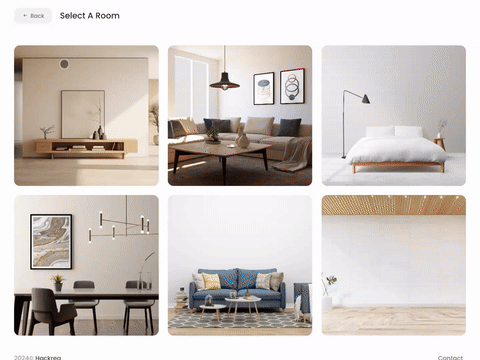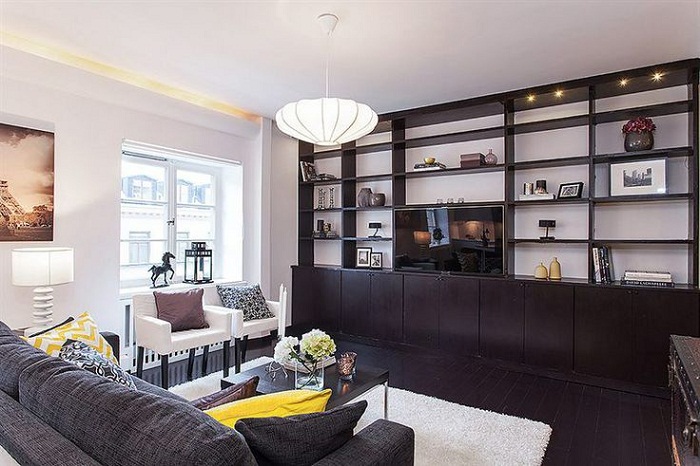Interior design in contemporary style

The trendy contemporary style is suitable for decorating an apartment, an office or a house. It is practical, functional and does not limit the interior designer to a rigid frame. Designers define the term “contemporary” in interiors in a contemporary style that does not match the aesthetics of high-tech techniques or laconic minimalism. The contemporary style appeared not so long ago, but has already won over fans around the world. Basically, thanks to the simple principles of interior decoration, which are based on common sense and convenience.
Historical aspect
The history of contemporary style begins in the middle of the 20th century. Scandinavian style, constructivism and minimalism are the basis. The small rooms of the individual and collective apartments have been decorated with modesty and conciseness, fitting perfectly into the decoration and the mass-produced furniture. Decoration, furniture and lighting fixtures were often purchased if they were available in the store, there was no need to choose much from the copies presented. Thus, in a modern apartment with a modest laconic decor, objects from different eras and different styles coexisted.
The contemporary style in post-war homes looked modern. At the same time, eclecticism was inherent in him. That is to say, in a modern minimalist interior, signs of other styles have been recognized. The diffusion of the contemporary in Europe was facilitated by the ideas of the Bauhaus school. The architects and designers who promote the school’s ideas have sought to create a mass of comfortable and affordable furniture.
At the end of the 20th century, such furniture was present in almost all European families. For example, a kitchen drawer or a wall in the living room. The promoters’ ideas were well received by the population, because the designers were able to offer functional, elegant and inexpensive furniture. Some furniture is still used in everyday life, with a modern look.
Contemporary interiors are topical, due to their unique ability to combine modern materials, decoration and Ikea furniture with objects from bygone eras. Designers predict long-term popularity for this style with slight modifications and transformations.
You can apply wallpapers, paints, etc. on walls and see how they look in various interiors.

What is the basis of contemporary style
To create an interior decoration in a contemporary style, you do not need to follow the strict rules of the historical era, observe the colors, buy designer furniture and sew custom curtains according to some sketches. All of this is unnecessary, as the style is based on a spontaneous neighborhood of furnishings that the owners have loved in the store. Style is a living embodiment of modernity. It allows you to use modern materials for decoration and to fill the interior of factory furniture in series, the main advantage of which is convenience. This style is very practical and easy to carry out. And therefore, it is often chosen by those who like to renovate and update the interior.
The basis of contemporary style is convenience, simplicity and functionality.
Simple lines and shapes
The simpler the construction of the room, the better it will be for the contemporary. The standard room of a multi-storey panel building is an ideal place for the realization of a modern interior. It is easy to insert simple and understandable lines and shapes – modern rectangular furniture and appliances, photos and paintings. At the same time, functional and inexpensive finishing materials, with a smooth and natural texture, provide a good background for them. For example, solid color walls, wooden floors and whitewashed ceilings. Or shiny stretch ceilings combined with laminate flooring and paneled walls. It’s simple: there are no niches, forged gratings and stained glass partitions, multi-level ceilings and stucco panels. For an interior in which it is good to relax and work with intensity, these details are superfluous.
Lots of free space
When doing renovations in a small contemporary apartment, designers try to leave as much space and vacuum as possible. To do this, remove all possible partitions and walls, zoning the area with modular furniture, lighting and podiums.
“Less is more” was the principle of the talented founding architect Bauhaus Mies van der Rohe. That is to say, the less various objects are placed in the room, the more free space remains.
Maximum functionality
Designers of functional furniture – the founders of contemporary – have sought to create spacious items that take up little space. Such an idea seems strange and implausible at first. But thanks to her, such essential household items have saved space in small apartments:
It should be noted that the first samples of such functional furniture were developed during the post-war period, but that they have not lost their relevance today.
Natural materials
Creating interior design in a contemporary style, quality modern materials are taken as the basis. It is preferable that they are made from natural raw materials and meet environmental requirements:
In addition to natural materials, modern industry offers a variety of artificial options that meet health and environmental standards. In addition, they most often have a beautiful decorative appearance and a long service life:
The right combination of textures
As a rule, the contemporary style in the interior does not involve a combination of bright colors, colorful patterns and designs. But at the same time, the situation does not seem pale and monotonous. The effect of liveliness and diversity is obtained through a combination of different textures: shiny, rough and mat.
Combine well in contemporary style:
Contemporary style color range
Modern interiors are characterized by neutral colors, which do not attract attention and are not annoying. Residents of modern cities appreciate the gray-brown hues associated with white surfaces and choose them more often than others. Color spots and accents use decor, furniture and living plants.
Such colors for the background:
As an accent, use small bright objects in these colors:
Contemporary style interior design rarely suggests the use of patterns, but natural textures are acceptable.
Among them:
Surface finishing methods
Contemporary interiors make it practical, zoned and comfortable. To do this, use natural and artificial materials when finishing surfaces.
For the soil:
For the ceiling:
For the walls:
Choosing furniture for a contemporary style
It was with the production of special functional furniture that the contemporary style began. Developers of folding, transforming, compact and multifunctional furniture projects and models, the creators presented a fashion for inexpensive and elegant items. The rise of mass-produced furniture from inexpensive materials occurred in the 60s of the twentieth century. But since then, it has not gone out of circulation, it is only slightly transformed by modernity.
Among the most sought-after contemporary furniture, such as:
A distinctive characteristic of contemporary furniture is its low cost, combined with a beautiful design and good resistance to wear. This effect can be achieved with modern materials – MDF, synthetic leather, mixed fabrics, laminate surfaces.
The lighting
So that interior decoration in contemporary style is of full value, pay attention to the good organization of lighting. In this case, natural and artificial light plays an important role. If the room has large windows, try not to hang them with thick curtains so that the most daylight can enter the room. Sheer curtains and blinds hang from the windows. If the room windows are small, several light sources are placed around the perimeter of the room.
Paths of lighting organization:
Contemporary interiors accept fixtures of the correct geometric shapes and models of whimsical shades. They should not have empirical pomposity and rococo elegance. The simpler the better.
Décor
Decorative objects enliven the calm and contemporary style inside. They can be brilliant, of different styles and eras. The owner of the apartment or the designer chooses the decor at his discretion. Often, large green plants are used as decoration: ficus, palm trees, ferns, bamboos. They decorate the interior and purify the air.
All the decorative elements of the interior recall various moments in life (business and vacation trips, shopping with friends, gifts for the holidays). In one way or another, the decor has value for the owner of the place, rarely uses foreign objects as decorative objects.
When filling the room with small decorative elements, it is important not to overdo it with a variety of colors and the number of items.









